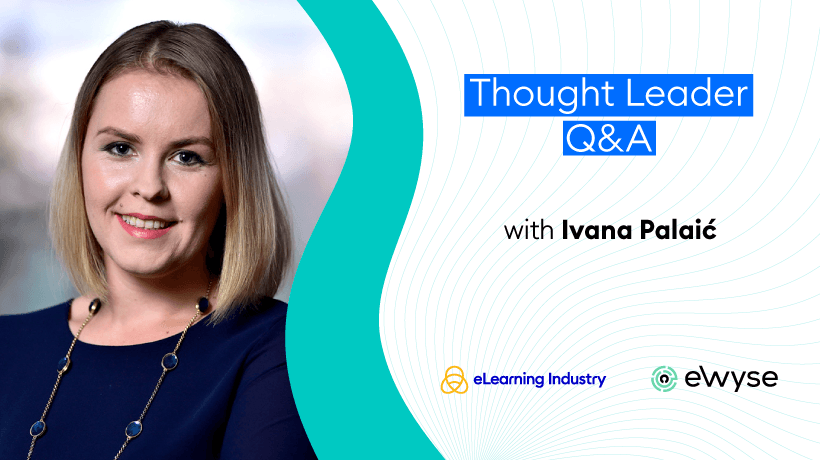What Part Does Project Management Play In eLearning Development Success?
Ivana Palaić is the Project Manager at eWyse, an all-in-one eLearning agency that builds tailored courses that engage, entertain, and educate, and designs customized solutions for clients all over the globe. Today, she speaks with us about how effective project management enables smooth collaboration between the production team, clients, stakeholders, and third-party providers, as well as why eLearning localization should never be an afterthought.
Why is effective project management so crucial in the eLearning course development process?
As a Project Manager in an eLearning agency, I'd say effective project management is absolutely essential in course development because it ensures that complex projects are delivered on time, within budget, and at the highest quality; all while keeping learners' needs and client strategic goals at the forefront.
What I've found is the biggest challenge is juggling multiple interconnected phases, from needs analysis, storyboard preparation, and Instructional Design to quality assurance, client reviews, and localization.
Coordinating this many components of eLearning development, especially when working with global teams, multiple stakeholders, and Subject Matter Experts (SMEs) across different time zones, requires a high level of structure and precision. Without strong project management, it's easy for delays, miscommunication, and scope creep to derail the process.
I believe strong project management is needed to:
- Maintain clear communication between clients, SMEs, and the development team.
- Prioritize tasks and manage resources efficiently.
- Mitigate risks by anticipating challenges and implementing timely solutions.
- Ensure quality through structured review and feedback cycles.
- Flexibly respond to client needs within the agreed scope, without compromising deadlines.
In my experience, managing eLearning projects combining Agile and Waterfall methodologies with clear, iterative feedback loops has been key to keeping complex and large-scale projects on track while staying flexible. This approach has helped me build trust and foster strong collaboration with clients, and it makes the workflow much smoother and more efficient overall.
How can projects that are run successfully empower companies to expand their L&D initiatives as well as boost learner satisfaction?
Let me answer that with an example. One of our clients, a global enterprise, embarked on a large-scale project involving 54 courses delivered in six languages. It's only normal that they came in with their own expectations and a vision for the project. However, after seeing the final product, they were pleasantly surprised by eLearning's true potential. The project showed them how scalable and flexible eLearning can be. Now, they're already planning to update and expand the courses, confident in eLearning's ability to evolve alongside their business.
This example highlights how successful project execution not only delivers on initial goals but also empowers companies to broaden their Learning and Development initiatives. When projects are completed on time, within budget, and aligned with learner needs and business goals, they build trust and encourage further investment in training.
Moreover, a well-managed project results in learning content that's engaging and relevant, as well as aligned with learners' needs. This boosts learner satisfaction and motivation, leading to higher course completion rates, knowledge retention, and more effective real-world application. The end result? Stronger performance and better business outcomes.
In short, a well-run project creates a strong foundation for continuous growth in L&D, while delivering meaningful learning experiences, and fostering a cycle where success fuels further innovation and investment.
What are the key elements involved in eLearning project management, and why is it so important to build realistic timelines from the get-go?
Managing an eLearning project successfully requires more than just ticking off tasks. It involves aligning several core elements, including comprehensive planning, clear and ongoing stakeholder communication, thoughtful resource allocation, proactive risk management, and structured quality assurance through iterative reviews.
Each project manager will naturally develop an approach that suits their team and business context best. Over time, we've identified three recurring pressure points for clients working with external agencies: creative alignment, process transparency, and budget clarity. These became the foundation for our own project management approach, something we call the "3C Framework" (our internal naming, rather than an industry-standard methodology).
The 3C Framework brings together the essential elements of eLearning project management into a fully transparent structure that keeps control in the hands of the client throughout the development process.
The three Cs stand for:
- Creative Control, which gives clients a structured feedback system at every stage so their input shapes both the content and design.
- Process Control, which ensures transparency and structure in managing timelines, deliverables, and communication, no matter how complex the project or how many stakeholders are involved.
- Financial Control, which provides full visibility into budgeting, scope, and time allocation, helping prevent surprises and maintain alignment with strategic goals.
Because each of these areas clearly outlines the stages of the development process, we can better anticipate challenges and plan ahead. Setting realistic timelines from the very beginning is crucial because it helps establish clear expectations, prevents rushed work, and allows sufficient time for meaningful feedback, revisions, and quality assurance.
One example that comes to mind is a client who aimed to develop nine master courses and localize each into five languages within four months. As expected, the localization process proved to be more time-consuming, especially due to the back-and-forth between translators and SMEs.
We quickly aligned on a new plan, which meant prioritizing the master courses first, while simultaneously preparing for the localization phase. During the development of the master courses, the SMEs prepared a glossary of key terms, clarified internal abbreviations, and set voiceover guidelines. We also assembled dedicated SME teams for each language. This preparation meant that when it was time to translate, the process was faster, smoother, and more consistent, without sacrificing quality.
Why should organizations not view eLearning localization as a secondary phase but as a highly specialized layer of project management?
eLearning localization is often seen as something that happens after the main course is complete, but in reality, it's a specialized, strategic layer of project management that should be planned from the start. It directly influences how effective, scalable, and inclusive a course will be across regions.
It's not just about translation, but about adapting content for cultural relevance, legal compliance, and platform accessibility. This includes everything from tone and visuals to local regulations and even formatting. These are complex processes that demand dedicated coordination, experienced teams, and clear timelines.
When the decision to localize is left until the end, it often causes delays, rework, or inconsistent learning experiences, such as missed cultural references, awkward phrasing, or tone that's out of sync with the original content. That's why it's important to build realistic timelines from the start, make the localization process transparent for clients and stakeholders, and put structures like glossaries and translation guidelines in place to ensure smooth collaboration when the time comes.
Of course, you can take different approaches to course development in terms of localization, and if you're curious which those are, we talked about this in our demonar "Lessons From The eLearning Localization Farm," so do check it out if you're thinking about localization.
Planning localization as a core project phase leads to smoother rollouts, better learner engagement, and a globally more consistent training.
What is one of your standout project management client success stories?
I've had the opportunity to manage a number of large-scale, complex eLearning projects, some of which have already been mentioned in this article. But one that I'd like to mention as a success story in terms of collaboration, adaptability, and impact is our work with the Global Health Advocacy Incubator (GHAI).
In this project, we developed a total of 27 courses: 9 in English and 18 localized into French and Spanish. The goal was to support global health advocates across multiple countries and time zones while making sure the learning experience was accessible, scalable, and impactful.
Maintaining timelines, aligning on feedback, and managing scope changes without losing momentum required clear structure, open communication, and a high degree of flexibility. On top of that, the courses had to be optimized for mobile and low-bandwidth environments while also offering downloadable templates and optional supporting materials to allow learners to tailor their experience.
That's where our 3C Framework played a key role. It gave GHAI full transparency and control throughout the project, from structured feedback loops to clear budget visibility. We applied a hybrid project management methodology, combining the structure of Waterfall with the flexibility of Agile. This allowed us to stay responsive to GHAI's pace, integrate feedback iteratively, and adjust priorities without compromising quality.
It wasn't just about managing the project, it was about building the partnership as well. We worked as one team, and the result was a robust, multilingual eLearning program with real global impact.
If you're curious to learn more about the course development process and our collaboration with GHAI, watch our joint webinar where we explored all this and more.
We've heard that eWyse is expanding into product development in addition to product delivery. Can you tell us a bit more about this new strategic direction?
Sounds like the word is getting out, and we're glad it is!
Yes, it's true, we're taking a bold step forward by expanding into product development. Even though project delivery remains our core strength, we're now using that same expertise to create our own solutions that support long-term learning goals.
Our first product is the AI Mentor, a smart learning assistant designed to guide learners, reinforce knowledge, and boost engagement. But what sets AI Mentor apart from general AI assistants is that it's purpose-built for learning. It works inside eLearning courses or as a standalone app, offering personalized, on-demand support tailored to specific training goals.
What makes it unique is how flexible and secure it is. Clients can fully customize its tone, role, and behavior to match their training goals. It runs in a closed environment, keeping all data protected and under client control.
This shift marks a new strategic direction for eWyse. By combining our project expertise with in-house product development, we're creating tools that bring even more value to learners and clients alike.
Wrapping Up
Thanks so much to Ivana for delving into how strong project management transforms complex eLearning projects into seamless, stress-free experiences. Check out their services and real-world success stories if you'd like to learn more about how eWyse can help you create engaging, inspiring, and impactful training.



